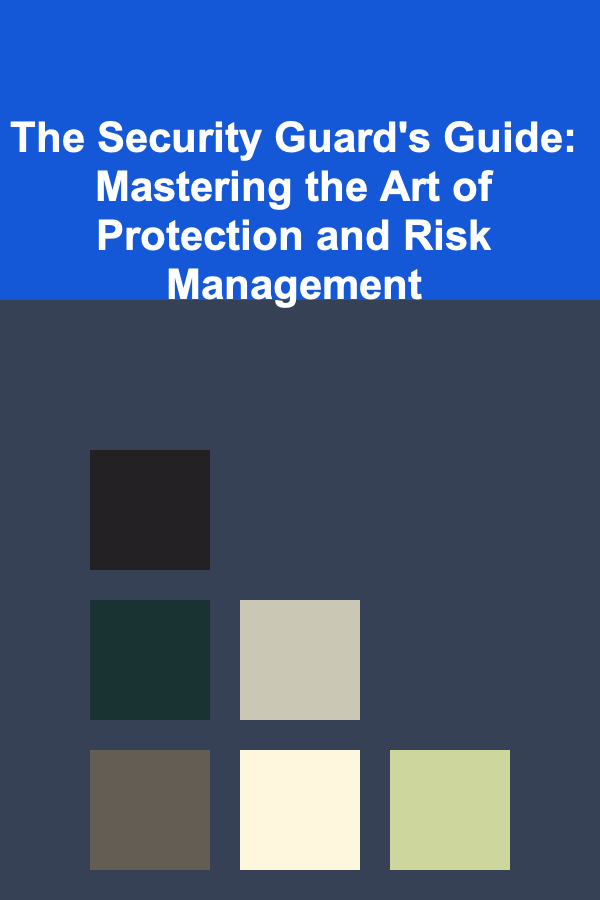
The Security Guard's Guide: Mastering the Art of Protection and Risk Management
ebook include PDF & Audio bundle (Micro Guide)
$12.99$10.99
Limited Time Offer! Order within the next:

In a world where security threats continue to evolve, security guards play a pivotal role in safeguarding people, property, and assets. As the first line of defense against potential risks, a security guard must possess a wide range of skills that extend beyond just monitoring a premises. The role requires a blend of physical, mental, and interpersonal skills, as well as a deep understanding of risk management to effectively mitigate and respond to potential threats.
This guide provides an actionable roadmap for aspiring security guards to master the art of protection and risk management. By understanding the core principles of security, mastering essential skills, and being proactive in risk identification and management, a security guard can not only ensure the safety of a given environment but also become an invaluable asset to any organization.
Understanding the Core of Security and Risk Management
Before diving into the specifics of becoming a skilled security guard, it's crucial to understand the fundamental concepts of security and risk management. A security guard's role is not just to prevent crime but also to manage risk in a dynamic environment.
Security is about protecting people, property, and information from threats such as theft, vandalism, fraud, or violence. It involves a proactive approach to identify potential risks before they occur.
Risk Management is the process of identifying, assessing, and mitigating risks to minimize harm and loss. In the context of security, this means understanding the threats to your specific environment and putting strategies in place to reduce the likelihood of these risks turning into actual incidents.
By blending these concepts, a security guard can develop a mindset that goes beyond reactive duties, enabling them to anticipate risks and mitigate them before they escalate.
Key Concepts of Risk Management:
- Risk Identification: Recognizing potential threats and vulnerabilities that could pose a danger to a building or facility.
- Risk Assessment: Evaluating the likelihood of these threats happening and determining their potential impact.
- Risk Mitigation: Implementing strategies and actions to reduce the likelihood of a risk occurring or minimizing the damage if it does.
Situational Awareness: The Foundation of Protection
Situational awareness is the cornerstone of effective security work. A security guard must be continuously aware of their surroundings and be able to detect signs of potential threats before they materialize. This skill involves both observation and analysis.
How to Enhance Situational Awareness:
- Regular Patrols: Conducting routine patrols of the premises allows you to spot any irregularities that could indicate a potential threat. Pay attention to details, such as changes in the environment, people acting suspiciously, or objects out of place.
- Understand the Environment: Familiarize yourself with the layout of the premises, including entry points, high-risk areas, and emergency exits. Knowing the environment inside and out allows you to identify anomalies quickly.
- Observe Behavioral Cues: People often give subtle signs of nervousness or unusual behavior, such as avoiding eye contact, appearing agitated, or loitering. These cues can help you assess if someone is planning to engage in malicious activities.
- Use Technology to Aid Awareness: Leverage security cameras, alarms, and motion detectors to help maintain situational awareness. These tools can act as early warning systems and provide additional insight into the security status of the premises.
Conflict Resolution and De-Escalation Techniques
In many security situations, a security guard is called upon to defuse conflicts or manage difficult situations. Whether it's dealing with an angry customer, a potentially dangerous individual, or a crowd, the ability to resolve conflicts peacefully is a critical skill.
Effective conflict resolution involves clear communication, empathy, and a calm demeanor. The goal is to prevent an escalation that could lead to harm or an emergency situation.
De-Escalation Strategies:
- Stay Calm and Composed: A calm approach often influences others to remain calm. Speaking slowly and in a steady tone helps to de-escalate heightened emotions.
- Listen Actively: Allow the other party to express their concerns. Listening attentively shows respect and can provide insight into the underlying issue, which can often lead to a resolution.
- Use Clear and Respectful Language: Avoid using threatening or aggressive language. Instead, be polite and professional while clearly communicating the desired outcome.
- Offer Solutions: Whenever possible, provide solutions or alternatives to the situation. Offering choices rather than ultimatums can help defuse tensions.
Emergency Response and Crisis Management
Security guards must be prepared to handle emergencies, ranging from medical incidents to fires or even active shooter situations. A swift, efficient response is critical in these high-pressure environments, as lives can be at stake.
Key Steps for Effective Emergency Response:
- Know the Emergency Protocols: Every facility should have specific emergency response procedures. Familiarize yourself with these protocols, including evacuation plans, the locations of first aid kits, and fire exits.
- First Aid and CPR Training: Basic first aid and CPR training can save lives during medical emergencies. Ensure you are certified and regularly refresh your skills.
- Calmly Assess the Situation: In an emergency, your ability to stay calm is essential. Quickly assess the situation to understand the immediate risks and take appropriate action. This may involve notifying law enforcement, directing people to safety, or administering first aid.
- Coordinate with Emergency Services: If professional emergency responders are needed, ensure that you are able to communicate clearly and provide them with the relevant information (e.g., nature of the emergency, location, number of people affected).
Understanding Legal Boundaries and Ethical Guidelines
A security guard is often in a position where they must enforce rules and take action in critical situations. However, it is crucial to know the legal boundaries of your authority to avoid overstepping and to protect both yourself and the organization.
Key Legal Considerations:
- Use of Force: Understanding the laws surrounding the use of force is essential. A security guard must know when they are legally justified in using force and to what extent. Unnecessary force can lead to legal consequences for both the individual guard and the company.
- Detaining Individuals: In some situations, a security guard may need to detain a person (for example, if they are caught in the act of committing a crime). However, it is important to know the legal requirements for detainment, including when to contact law enforcement.
- Privacy Laws: Security guards often deal with sensitive personal information or witness situations where privacy rights are involved. It's essential to understand privacy laws (such as those protecting employees or customers) and ensure that personal data is handled responsibly.
- Ethical Conduct: Above all, a security guard must operate with a high level of ethical integrity. This includes respecting individuals' rights, being honest in all reports, and always acting with professionalism and fairness.
Risk Assessment and Prevention Strategies
Effective risk management requires continuous evaluation of potential threats. Risk assessment is an ongoing process that involves identifying vulnerabilities, understanding threats, and taking steps to mitigate those risks before they turn into actual security incidents.
Conducting a Risk Assessment:
- Identify Vulnerabilities: Start by evaluating the physical environment. Are there any access points that are unguarded or poorly lit? Are security systems outdated or inadequate?
- Evaluate Threats: Consider the types of threats that could impact the security of the facility. These may include burglary, vandalism, workplace violence, or even natural disasters like earthquakes or floods.
- Prioritize Risks: Once risks have been identified, assess their potential impact and the likelihood of them occurring. Focus on high-impact, high-likelihood threats first.
- Implement Preventive Measures: Once risks are assessed, develop and implement strategies to prevent them. This could include improving security infrastructure, changing policies, conducting regular drills, or training employees to spot security risks.
Technological Proficiency and Adaptability
As security technologies evolve, so too must the skill set of a security guard. Today, guards must be proficient in using various types of security technology, including surveillance cameras, alarm systems, and access control systems. Staying up-to-date with technological advancements allows a security guard to perform their job more effectively and efficiently.
Leveraging Technology in Security:
- CCTV and Surveillance Systems: Learn how to operate, maintain, and troubleshoot security cameras and surveillance systems. These tools help you monitor large areas and capture footage that could be vital in investigations.
- Access Control Systems: Understanding how key card access, biometric scans, and facial recognition systems work is crucial for monitoring who enters and exits the premises.
- Security Software: Many organizations use security software to manage systems, track incidents, or maintain logs. Familiarizing yourself with these systems will streamline reporting and enhance overall security management.
Customer Service: The Human Element of Security
While security is primarily about protection, the human element should not be overlooked. A security guard often serves as the first point of contact for visitors or employees entering a facility. By developing strong customer service skills, a guard can build rapport, improve the experience for those on-site, and foster a positive environment while still maintaining security.
Building Customer Service Skills:
- Be Approachable and Professional: Security guards should maintain a friendly yet professional demeanor. Greet people politely, answer questions when appropriate, and assist visitors in navigating the facility.
- Respectful Interactions: Even in tense situations, always treat people with respect. Your ability to communicate effectively, whether de-escalating a confrontation or offering directions, can help foster trust in your role.
- Maintain a Positive Attitude: A positive attitude helps set the tone for interactions. Whether you're dealing with a disgruntled visitor or a routine situation, a calm and approachable demeanor can make a significant difference.
Conclusion
Mastering the art of protection and risk management as a security guard requires continuous learning, adaptability, and a comprehensive set of skills. By honing your situational awareness, improving your crisis management capabilities, understanding legal and ethical boundaries, and embracing modern technology, you can ensure the safety of your environment while effectively managing risk. This guide offers the foundational principles needed to not only become a competent security guard but also a proactive and invaluable risk management professional.

How to Become a Successful Grant Writer
Read More
How to Develop a Mindset for Wealth and Financial Success
Read More
How to Organize a Last-Minute Home Party Without Stress
Read More
How to Organize Your Wardrobe with Limited Closet Space
Read More
How to Stage Your Home's Kitchen to Boost Its Appeal
Read More
What Should You Know About Organizing Your Car for Road Trips?
Read MoreOther Products

How to Become a Successful Grant Writer
Read More
How to Develop a Mindset for Wealth and Financial Success
Read More
How to Organize a Last-Minute Home Party Without Stress
Read More
How to Organize Your Wardrobe with Limited Closet Space
Read More
How to Stage Your Home's Kitchen to Boost Its Appeal
Read More